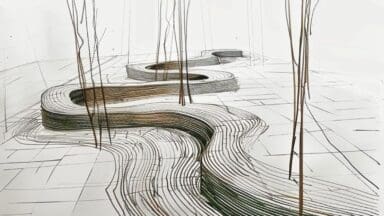
Designer, Tom Hoblyn, is creating the Hospice UK Garden of Compassion for the 2025 RHS Chelsea Flower Show to demonstrate the importance and role of thoughtfully designed spaces for providing comfort at the end of life for patients, families and staff. Speaking to Hoblyn about the project, I was struck by the detail and profound sensibility in his approach to translate this big responsibility, into a garden.
“I originally planned for 2023 to be my last RHS Chelsea Flower Show, ready to hand over to a younger generation. However, after working on a delayed garden for Haven House Children’s Hospice, I saw firsthand how vital hospices are and got to know the families and staff. So, when Hospice UK approached me, I couldn’t say no – it was the right moment to combine my passion for design with a cause I deeply care about. This is an exciting chance to demonstrate ideas I firmly believe in and push boundaries,” explained Hoblyn.
A Fellow of the Society of Garden Designers, Hoblyn is a British landscape designer and horticulturist, with a strong passion for plants. Working to his philosophy of ‘gardens for purpose’, Hoblyn designs spaces that foster biodiversity, support wellbeing and work in harmony with their surroundings. He has won three gold, four silver gilt and two silver medals at RHS Chelsea and RHS Hampton Court. He won the People’s Choice Award for the 2012 RHS Chelsea Arthritis Research Garden, and a nomination for The People’s Choice of The Decade Award in 2020.
A landscape inspired garden
The design for the 2025 RHS Chelsea Hospice UK Garden of Compassion, is inspired by Mediterranean landscapes and specifically the spirit instilled by the Olive Houses in Mallorca. Hoblyn’s design is definitely not a pastiche slice of Mediterranean mountain side taken to Chelsea, but a rather more ambitious project – a wild landscape inspired ornamental garden that will help connect hospice patients to nature.
“Connecting people with nature, can help make even tough times, more positive. The more you can ground people within nature, it can help in end of life for the patient and their family, carers and staff,” he said.
Surrounded by thousand year old olive trees planted on man-made terraces of dry stacked stone, Mallorca’s purple stucco olive houses are built in and amongst age-old, craggy boulders embedded in the landscape – an example of how the wild and human-nature can intertwine. For Hoblyn, it was the interconnected spaces amongst the houses, boulders, dry-stone terraces, that inspired him as they offered the possibility of secluded corners for quiet moments to more open spaces for more communal use.
“The Olive houses are built on and amongst these huge stone boulders, which I loved. The little houses were built, without moving any boulders out the way and because they were there for centuries before, you feel very much grounded by them and I thought, wouldn’t that be great to try and reflect that Chelsea?”
Taking the essence of the interconnected spaces, the garden features dry stone walls which segment the garden into rooms, interplanted in Mediterranean aesthetic of soft silvers, olive greens, vibrant blues, burnt oranges and warm yellows. Set against the dark foliage and bark of trees such Arbutus andrachne, Luma apiculate and Acer monspessulanum, unusual plants such as Delphinium peregrinum, Ficus ‘Crystal Ice’, Lotus hirsutus and Hunnemannia fumariifolia set the scene.
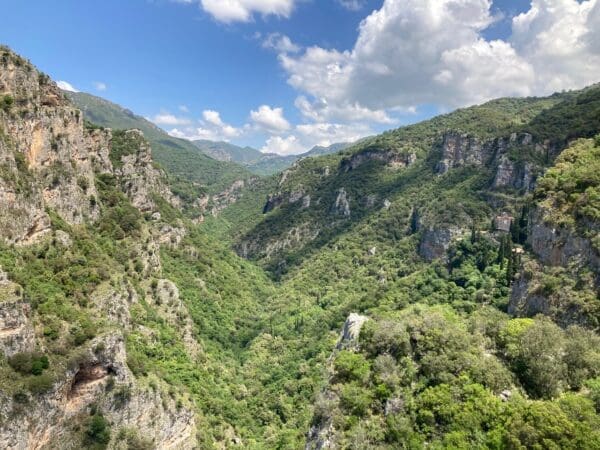
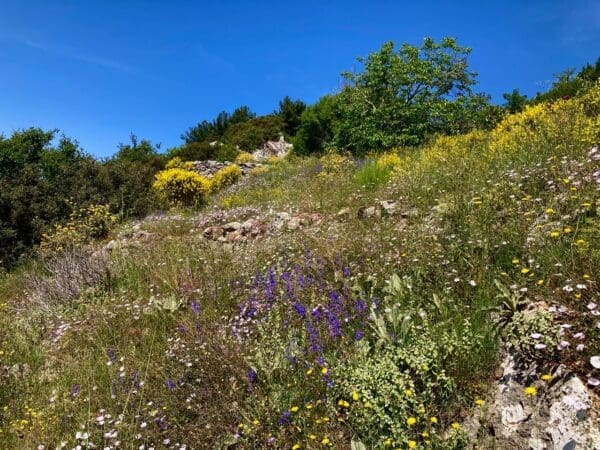
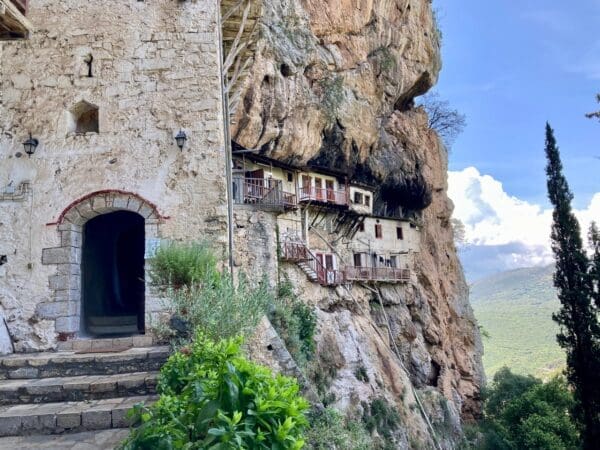
Drought tolerance is an important factor in the plant choices, but even more so is their visual appeal and sensory impact for the end of life patients. “I am passionate about climate resilience but that is only partly why I chose the Mediterranean theme. I found it to most effective to achieve that grounding feeling, and also for its sensory experience. You can really ramp up the sensory experience with the colours, fragrance from aromatic leaves, textures and sounds from moving grasses,” explains Hoblyn.
After the show, the garden will be relocated to St Cuthbert’s Hospice in Durham. Designing a show garden for often challenging final locations, can be a difficult balance. Fortuitously for Hoblyn, the backdrop to the hospice provides extended views over the River Browney valley, where the oolitic limestone formations serve fortuitously as an extension for the garden’s dry stone walls and boulders.
The garden’s boulders are being sourced from the neighbouring Raby Castle. Using reclaimed materials is not only sustainable and befitting of the Mediterranean ‘make do and mend’ attitude Hoblyn so admires, but also as a recurring message of sustainability which runs throughout the garden. “We’re using reclaimed paving, the gravel is a by-product of the road industry from the quarry, so everything is reclaimed and has a new lease of life in the hospice garden. Poignant too, because it was at the end of its lifecycle, and then we’ve taken it and given it new life. So we have this whole circle of life thing going on, echoing what happens at a hospice.”
Attentive design
Hoblyn is known for his sensitivity of touch in his work, be it to the climate resilience or in this case, a deep understanding for the patients and families facing the hardships of end of life.
Hospice UK’s Garden of Compassion is not his first garden for a hospice charity. Hoblyn designed the children’s hospice garden at Woodford Green in Essex and during lockdown, he worked on Haven’s House Hospice – a particularly awful time when bereaved family members were unable to see their loved ones. Hoblyn talked to children, parents, siblings and saw what they were all going through. “So when I was asked to design Hospice UK’s garden, I thought I’ve got to do this. I have to,” he said.
To evoke the vital feeling of togetherness, Hoblyn has designed an extensive, sinuous oak bench which weaves throughout the garden, uniting the various spaces. Though it looks as one streamlined feature, the oak bench, is designed in five separate sections. Hoblyn, explains that his experience of working on hospice gardens, he saw that wheelchair users or bed-bound patients are often saddened and resent being “stuck at the end of the bench”. At a time when being surrounded by family is key, the gaps in Hoblyn’s meandering bench allow patients to be amongst their loved ones.
“Some patients can sit on their own, whilst in other places, more people can sit from groups of three to seven. Weaving throughout the garden, the bench ties the rooms together. I’m calling it the together bench because it’s where everyone can be together.”
Hugely tactile and ergonomic, the Together Bench(es) are crafted from a fallen oak and given new life to offer patients, their families and hospice staff a place in which to sit in the garden, to help find moments of togetherness, comfort and respite from the challenges they face. Made by furniture maker, Mark Tungate in Okehampton, the bench has been made using traditional steam bending techniques.
Adding to the garden’s sense of tranquility and reflection, a series of water bowls support both the emotional and physical needs of the patients in hospice care. Made by the ceramicist, Thea Thompson the bowls are made using the Roman cement technique, where the binding agent is made from ground-up oyster shells from the oyster fishery in Lindisfarne, Northumberland.
“My drawings and colour palette, are all done by hand. And so too in the garden, all is being done by hand. The dry stone walls, the rendering, the bowls, the bench. The garden is very inspired by proper arts and crafts because I feel we’re in a world of technological overwhelm and therefore I’m determined to do everything by hand.”


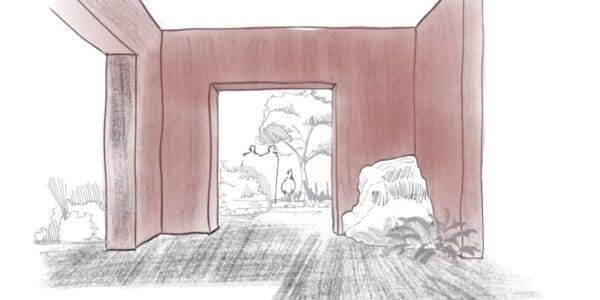
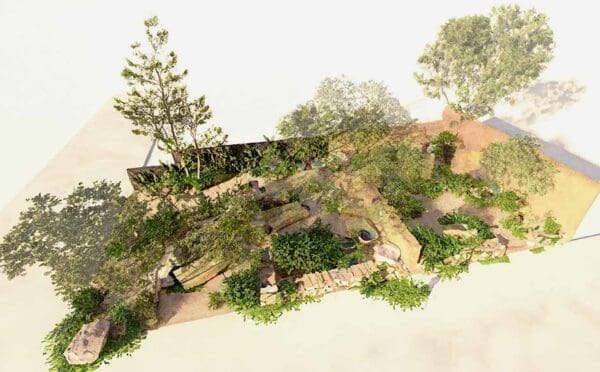
Growing plants
Growing plants for RHS Chelsea is not for the faint hearted. The handful of nurseries that have perfected this nail-biting process, grow not just vast quantities to ensure only the top quality plants are delivered to the show, but spend an arduous year battling varied weather conditions, juggling plants between polytunnels and exposed locations to ensure they only peek at the exact time for both the start, as well as the duration of the show.
If the pressure of designing an RHS Chelsea garden wasn’t enough, Hoblyn has also been growing specialist plants for the garden. The Kew trained Hoblyn, “100% motivated by plants” said: “Growing them helps keep you in tune with your planting, as I’m constantly going through all the planting in my mind. It’s really one hell of a way of grounding yourself, isn’t it?”
RHS Chelsea veterans, Hortus Loci are growing the vast majority of the plants for the garden, but Hoblyn’s selection of special gems are being grown in the polytunnels at his son’s tree nursery, Rymer Trees and Hedging and include the likes of: Isatis tinctoria, Antirrhinum majus supbsp. majus, Papaver glaucoom, Centranthus lecoquii and Lilium candidum.
“For many years, I have been trialling plants I liked, to see how they would perform in Suffolk because it’s very dry up here. I thought, that they could really work for the garden and you just don’t see them in the UK. I have about 8 or 9 different species, which I’m working with. Some of which I want to flower early, to show seed heads, others for foliage or for the flowers. Of course, I don’t have the experience that Hortus Loci have of growing year after year for Chelsea, but it’s nice to know that these will come from my garden, grown for the show.”
Hospice UK will be raising additional funds for the garden’s relocation by means of an RHS Chelsea plant sale, taking place at Hortus Loci, after the show.
Dream team
In addition to Hortus Loci and the best of British craftsmanship, Hoblyn is working Mark Wyman, Peter Harket and their talented landscaping team to build the garden. Wyman and Harket were key players in the Crocus landscaping team led by Mark Fane and Peter Clay, whom were behind some of the most memorable RHS Chelsea Gardens – working alongside many of the world’s best designers, such as Tom Stuart-Smith, Dan Pearson, Andy Sturgeon, Cleve West and Sarah Price.
“Mark Fane and Peter Clay may have retired, but the team hasn’t,” smiled Hoblyn. For 2025, Wyman is only building UK Hospice garden, bringing a level of sole focus that Hoblyn specifically wanted from a contractor.
In true ex-Crocus organisation & style, the garden has already been mocked up, with all the boulders, trees, walls and plants placed to ensure the garden works and offers the best views for the audience. “Doing that has certainly taken the pressure in a way. I’m very blessed to have this team. I’m truly very lucky to have them.”
With such care and thoughtful detail, I have little doubt that Hoblyn’s UK Hospice Garden will shine at RHS Chelsea, but more importantly, the efforts and detail will provide the patients and their families a tranquil place at St. Cuthbert’s – offering a much needed place of solace and support to help cope with what will undoubtedly be, the most difficult times of their lives. As his final RHS Chelsea foray, I can’t think of a more worthwhile and lasting legacy. Bravo Tom.
The Hospice UK Garden of Compassion has been fully funded by Project Giving Back.

